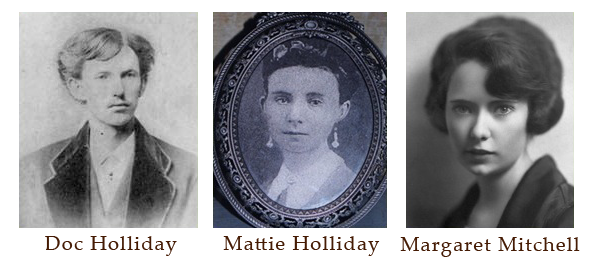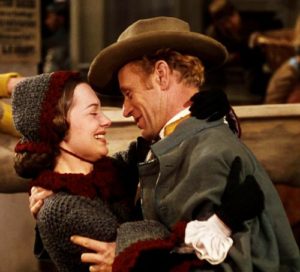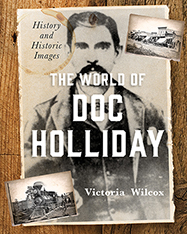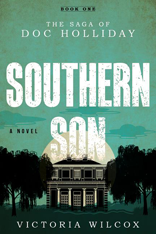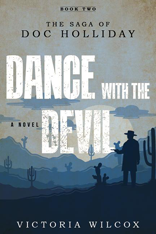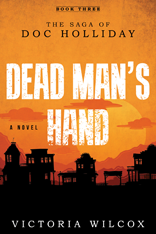“I was in love once. My first cousin. She was… We were both so…
She joined a convent over the affair.
She was all I ever wanted.”
Those are Doc Holliday’s words in his tragic but touching final scene from the film “Tombstone,” the cult classic that made Doc lovable and relatable again after a generation of his being cast as a movie villain. In Kevin Jarre’s brilliant version of the West’s most famous gunfight, gambling dentist Doc Holliday is lawman Wyatt Earp’s most loyal friend – and the heart of the whole story. Partly that comes from Jarre’s own script which gave Doc so many quotable lines. Partly that comes from actor Kurt Russell’s generous editing of the filming script that cut out many of Wyatt’s lines in favor of a focus on Doc. For as every follower of Westerns knows, if you have a sympathetic Doc Holliday, you have a hit movie.
But what about that iconic final scene, as Doc confesses his young love and then dies? Was that Jarre’s dramatic invention or Russell’s addition? Or was it based on something from Doc Holliday’s own life?
According to old Holliday family stories, the young romance between Doc and his first cousin really happened – and may have been one of the reasons he left Georgia. The girl was Martha Anne “Mattie” Holliday, daughter of Doc’s uncle Robert Kennedy Holliday. Doc (then just John Henry Holliday) grew up in the little city of Griffin, Georgia, while Mattie grew up in Jonesboro, thirty miles or so up the road. Although the families were a bit separated in those horse-and-buggy days, they gathered together whenever they could, often at the home of Doc’s medical doctor uncle, John Stiles Holliday, in nearby Fayetteville. Mattie was eighteen months older than John Henry, but the two were close as children and remained close – and reportedly even had a romance when they were teens. While we might not consider cousins as appropriate sweethearts, in 19th century America cousins did sometimes fall in love and marry. As Margaret Mitchell says in the classic novel of the Old South, Gone With the Wind: “The Wilkes and Hamiltons always marry their own cousins.” She was referring, of course, to Ashley Wilkes (Scarlett O’Hara’s crush) marrying his cousin, Melanie Hamilton.
And that’s where the story of Doc and his cousin Mattie crosses into the story of Gone With the Wind, for Mattie Holliday was also cousin to author Margaret Mitchell, and became the real-life model for the fictional Melanie Hamilton. Mitchell even borrowed Mattie’s name, and not just the initials M.H. In her later years, Mattie Holliday became a nun and took the name Sister Mary Melanie, and was known as Sister Melanie Holliday. And could it be just a coincidence that the name Melanie comes from a Catholic saint named Melania who married her own first cousin? Catholics were more restricted in their marriage choices and not allowed to marry “in the first degree” (meaning a first cousin), only in the more distant “second degree” (meaning a second or less related cousin) — what became known as “kissing cousins.” When Saint Melania discovered her error she left her husband and took religious orders, entering a convent. Did Catholic Mattie Holliday have the same dilemma, loving her own first cousin but not being allowed to marry him?
We’ll never know the personal thoughts and private emotions of Doc Holliday and his beloved cousin Mattie, but we do know that they remained close through the years and kept up a correspondence throughout his travels in the West. When he died in Glenwood Springs, Colorado, the local paper recorded:
“He had only one correspondent among his relatives – a cousin, a Sister of Charity, in Atlanta, Georgia. She will be notified of his death, and will in turn advise any other relatives he may have living. Should there be an aged father or mother, they will be pleased to learn that kind and sympathetic hands were about their son in his last hours, and that his remains were accorded Christian burial.”
His personal belongings, and their letters to one another, were sent to Sister Melanie in Georgia and kept in the Holliday family for many years. After Sister Melanie’s own passing the letters were often shared at family gatherings – until her younger sister burned them to keep them private. But did she find and burn them all? Or might there still be some of those letters remaining as written proof of Doc’s lasting affection for his cousin Mattie? It’s one of the mysteries that makes Doc Holliday remain one of our most fascinating – and romantic – of Western legends.
Fun Links:
Filming Script for the movie “Tombstone”
True West Magazine article on the Tombstone script
Gone With the Wind Tour
31 Kissing Cousins
Kissin’ Cousins: Melanie Hamilton and Ashley Wilkes
Click the book cover below for more info or to order.
